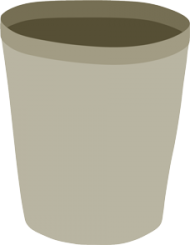Bin Audit
A bin audit is a great way to take stock of what waste you could be avoiding, and improve your composting and recycling habits.

What can you do
Conduct a garbage bin audit to discover all the ‘waste’ that could be avoided, recycled or composted.
How you can do it
Whether at home, school or in your workplace, bin audits are a great way to understand waste you’re creating and discover any confusion about the alternatives. For example, if your bin audit shows that family members, classmates or co-workers are putting cardboard in the landfill bin, you can check to see if there is a service for it to be recycled.
Getting Set up
- If you’re at work or school gather together a team of colleagues/classmates/teachers who are keen to conduct a bin audit. It’s a much quicker and more fruitful process if conducted with a few people. Otherwise, at home, you can tackle the task by yourself or get the other members of your household involved.
- Pick a day not long after your bins have just been emptied (you don’t want to rummage through week-old waste). Make sure that you’ve given sufficient time for the bins to collect waste, but not too long that it’s started to go putrid.
- Find a location that’s sheltered, has good airflow and is easy to clean. Make sure that the waste won’t blow away in the wind, too.
- Source some tarpaulin from a friend, neighbour, or colleague.
- Optional: gather some buckets and scales to calculate the volume and weight of the waste you audit.
- Draw a table so you can keep a record of the waste you find. You may find you just need two columns: Category of waste and weight/volume. However, it’s always handy to prompt yourself to write the date, who helped with the audit, and what type of bin you were auditing (compost, general waste, recycling).
- Find some gloves (preferably washable) so that your hands stay clean.
On the day
- Gather your rubbish bin(s). Separate them by type (this may be: compost, recycling, general waste but it depends on the separation system in your home, school or workplace).
- Start with one type of rubbish and empty it all onto the tarpaulin.
- Separate the rubbish into piles. For example, you may separate the general waste bin into: batteries, paper, food, plastic bottles, plastic cutlery, soft plastic, cans, cardboard, glass.
- Estimate the volume or percentage of waste in each pile (or accurately weigh if you have scales) and write this in your table.
- If you have other bins, repeat this process with them, then clean up.
Taking the next steps
Once you’ve audited your bin, there’s a lot of useful information that can come from it. Start by taking note of the “low hanging fruit”; in other works, things that you can change quickly and still make a big impact.
Focus on those one or two items and figure out how you can improve. It might be eliminating a certain item or product that ends up in your waste a lot, or sourcing a local recycling centre for items that can’t go in the regular recycling bins.
Set SMART (Specific, Measurable, Attainable, Relevant, Time-based) goals to reduce each item found in your bin audit. Reflect on these goals on a regular basis, and conduct a bin audit every 6 or 12 months to track your progress.
The Impact
- Reduce waste that needs collecting and reduce transport pollution.
- Engage with family members or employees on their waste, helping them to share specific behaviours they can change.


